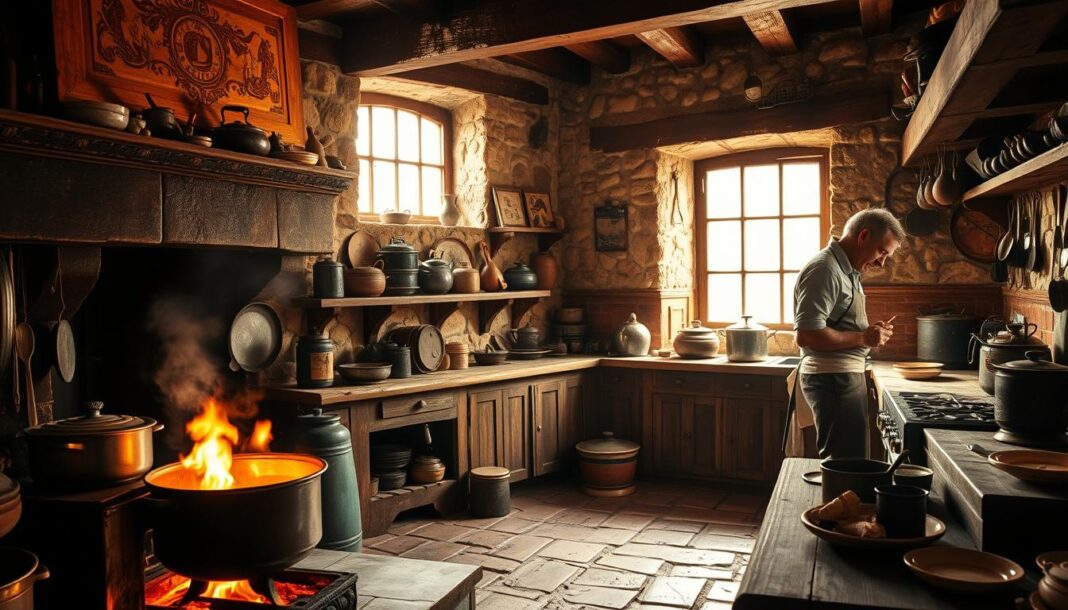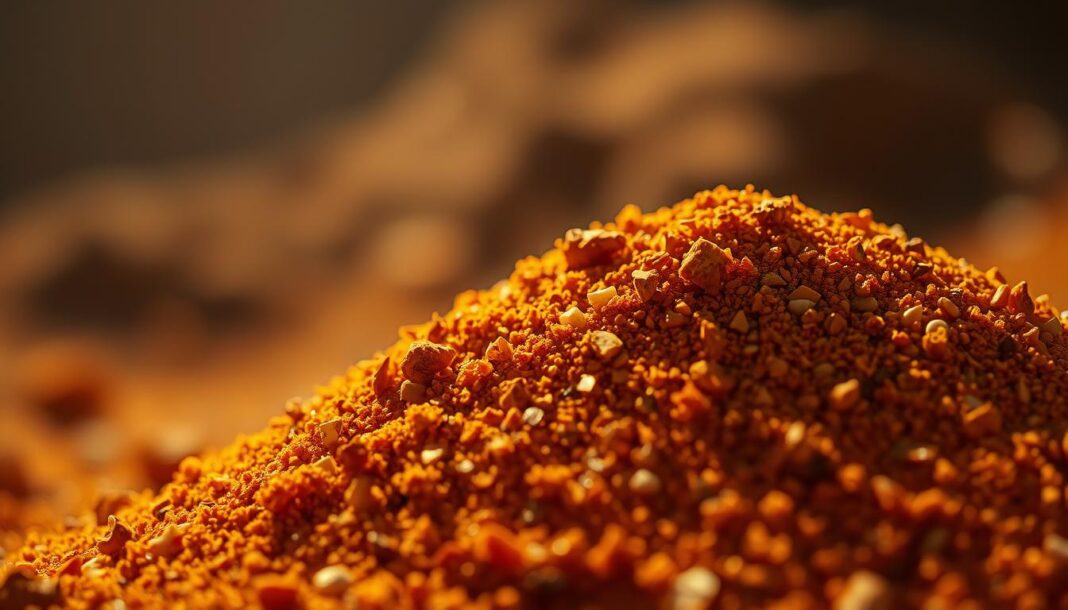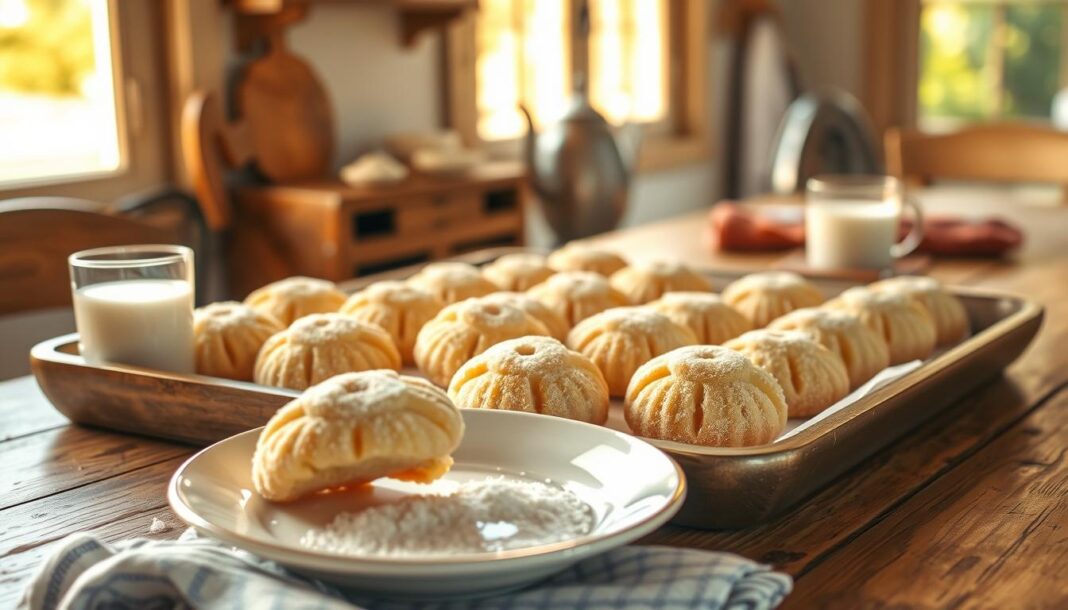Embark on a culinary journey through time with us as we explore authentic recipes that have shaped our gastronomic heritage. From medieval banquet halls to 18th-century British estates, we’ll guide you through the fascinating world of cooking, helping you decipher ancient measurements and adapt traditional techniques for modern kitchens.
Using ingredients like sugar, flour, and eggs, we’ll show you how to recreate dishes from the past, revealing the cultural and social aspects of past civilizations. By preserving culinary traditions, we connect with our ancestors through the universal language of food.
Key Takeaways
- Explore authentic historical recipes from various centuries and continents.
- Learn to adapt ancient measurements and cooking techniques for modern use.
- Understand the cultural significance of preserving culinary traditions.
- Discover how ingredients like sugar and spices shaped cooking techniques.
- Recreate dishes from different historical periods with expert guidance.
The Fascinating World of Historical Cuisine
Historical cuisine offers a window into the past, revealing the traditions, values, and practices of bygone eras. As we explore the fascinating world of historical cuisine, we uncover the significance of food in shaping cultural identities and understand how historical recipes continue to influence our culinary practices today.
Why Historical Recipes Matter
Historical recipes are more than just instructions for preparing meals; they are gateways to understanding our cultural heritage. These recipes, often passed down through generations, serve as living artifacts of community values and traditions. For instance, the use of sugar in historical recipes not only reflects the economic and trade practices of the time but also highlights the cultural exchange that occurred through the spice routes.
The significance of historical recipes can be seen in their ability to connect us with our past. By studying these recipes, we can gain insights into how our ancestors lived, what they ate, and how they cooked. This understanding can be achieved by examining the ingredients used, such as flour for bread and eggs for various dishes, and the cooking techniques employed.
| Ingredient | Historical Significance | Culinary Use |
|---|---|---|
| Sugar | Reflects trade practices and cultural exchange | Baking, desserts |
| Flour | Staple ingredient in bread making | Bread, pastry crust |
| Eggs | Source of protein, symbol in various cultures | Baking, cooking |
The Connection Between Food and Cultural Heritage
Food traditions form a cornerstone of cultural identity, with recipes passed down through generations serving as a testament to heritage and community values. Historical food recipes often reflect religious practices, seasonal celebrations, and cultural ceremonies, demonstrating how food connects to broader aspects of social life. The migration of recipes across borders reveals stories of cultural exchange, conquest, and diaspora, with dishes adapting to new ingredients and tastes while maintaining core elements.
For example, the introduction of new world ingredients like potatoes and tomatoes dramatically transformed European cuisine, showing how food history connects to global economic and political developments. Regional variations in historical recipes demonstrate how geography, climate, and local resources shaped distinct culinary identities that persist today.
Reviving historical recipes allows communities to reconnect with their cultural heritage, which may have been disrupted by modernization, migration, or cultural assimilation. By exploring historical cuisine, we not only preserve culinary traditions but also gain a deeper understanding of the complex interplay between food, culture, and history.
Understanding Historical Food Recipes
Unlocking the secrets of historical food recipes requires a deep understanding of the techniques and ingredients used in the past. As we explore these recipes, we find that they are not just about sustenance, but about culture, tradition, and community.
To cook historical recipes effectively, we must first decipher the old cooking instructions, which often involve archaic terminology and unfamiliar techniques. This process can be challenging, but it is also a rewarding journey into the culinary past.
Deciphering Old Cooking Instructions
Old recipe books and manuscripts often contain instructions that are vague or use terms that have fallen out of common use. For instance, a recipe might call for “beating eggs until they become light and fluffy,” without specifying the duration. In such cases, understanding the techniques and tools available at the time can provide valuable insights. We can use historical recipes as a guide to learn more about these techniques.
Modern appliances like electric mixers have made tasks such as beating eggs for an hour more manageable. However, to achieve authentic results, we should consider the original manual techniques, such as using a mortar and pestle to grind spices.
Common Measurements and Terminology
Historical recipes often use measurements and terminology that are unfamiliar to modern cooks. Terms like “a pinch of salt” or “a handful of sugar” were common, but these measurements can be subjective. Understanding these terms requires a knowledge of historical culinary practices and the tools used for measurement.
For example, a “cup” of flour might not be the same as a standard cup measure today, as it could refer to a heaped or packed cup. Similarly, ingredients like sugar were often measured in terms of weight or volume, using units like pounds or pints.
| Historical Measurement | Modern Equivalent |
|---|---|
| A pinch of salt | 1/8 teaspoon |
| A handful of sugar | Approximately 1/2 cup |
| A cup of flour | 120g or 4 oz |
Adapting Historical Techniques to Modern Kitchens
Adapting historical recipes to modern kitchens involves more than just substituting ingredients or adjusting cooking times. It requires an understanding of the original cooking techniques and the equipment used. For instance, historical recipes often relied on hearth cooking or wood-fired ovens, which provided a different heat profile compared to modern electric or gas ovens.
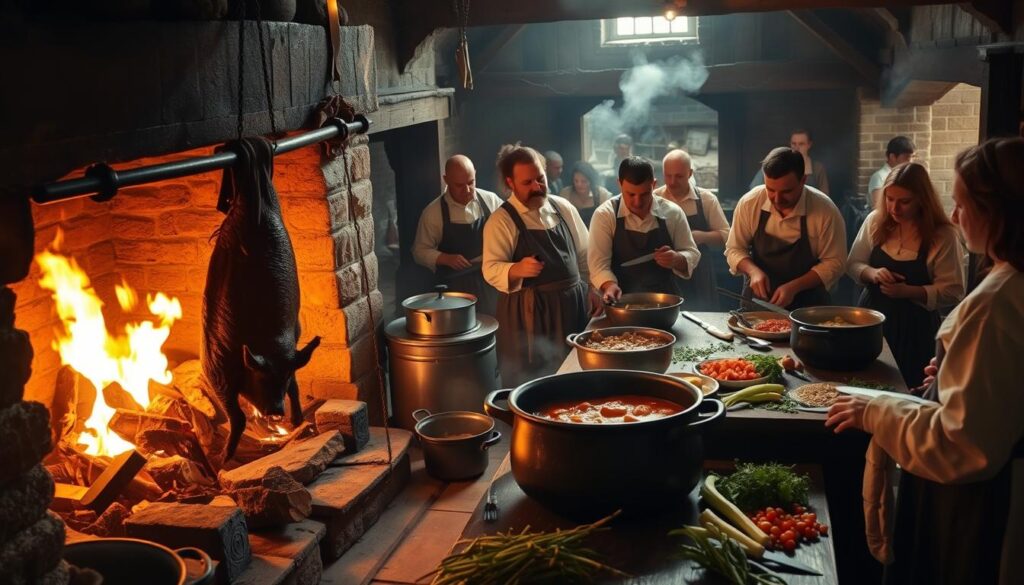
When recreating historical recipes, we must consider these differences. Modern ovens provide consistent, controlled heat, unlike the variable temperatures of hearth cooking, requiring adjustments to baking times and temperatures. Additionally, we should be mindful of food safety standards, especially when dealing with ingredients like raw eggs or unpasteurized dairy.
By understanding the historical context and techniques behind these recipes, we can successfully adapt them to our modern kitchens, preserving the essence of the original dishes while ensuring they are safe and enjoyable to eat.
Essential Tools for Historical Cooking
Recreating historical meals requires more than just old recipes; it demands the right historical cooking equipment or modern substitutes. To authentically cook historical dishes, understanding the tools originally used is crucial, as well as knowing how to adapt these to modern kitchens.
Traditional Cooking Equipment
Historically, cooking was done using equipment that was available at the time, such as cauldrons, brick ovens, and Dutch ovens. These tools were essential for preparing a variety of dishes, from stews and pottages to bread and pastry. For instance, cauldrons suspended over low hearth fires were ideal for slow-cooking stews.
Traditional baking often involved brick ovens or Dutch ovens buried in coals, requiring precise control over temperature and moisture. Historical cooks also relied heavily on manual tools for tasks like chopping, grinding, and pounding ingredients, which were labor-intensive processes.

Modern Substitutions
Fortunately, many modern tools can effectively substitute for historical cooking equipment, making it easier to recreate historical recipes in today’s kitchens. Some of these modern substitutions include:
- Electric slow cookers, which can simulate the gentle, long cooking process of cauldrons over low hearth fires, ideal for historical stews and pottages.
- Modern ovens with temperature controls, which can replace brick ovens or Dutch ovens, though adjustments in cooking times and moisture may be necessary.
- Food processors, providing an efficient alternative to manual chopping, grinding, or pounding ingredients.
- Silicone baking mats and parchment paper, which can substitute for greased paper, buttered cloths, or flour-dusted surfaces used in historical baking.
- Digital thermometers, removing the guesswork from achieving proper temperatures for sugar work, meat doneness, or bread baking.
- Stand mixers with dough hooks, replacing the physical labor of kneading bread dough by hand.
By understanding both traditional cooking equipment and their modern substitutions, we can more accurately and easily recreate historical recipes, bringing the past to life in our kitchens. Whether you’re making a historical dish that requires precise sugar work or baking a traditional pastry, using the right tools is essential for achieving authenticity.
Medieval European Delicacies
As we explore medieval European delicacies, we uncover the roots of many contemporary culinary traditions. Medieval cuisine was not just about sustenance; it was an art form that reflected the social, cultural, and economic contexts of the time.
French Wheat Berry Porridge
One of the staple dishes in medieval France was wheat berry porridge, a simple yet nourishing meal made from wheat berries, water or broth, and sometimes sweetened with sugar. This dish was a common breakfast food among both the peasantry and the nobility, albeit with variations in ingredients and preparation methods.
The preparation of wheat berry porridge involved boiling wheat berries in water or broth until they were soft, then seasoning with salt, herbs, or sugar. The porridge was often served with bread or sometimes with a fried egg on top, adding protein and flavor to the dish.
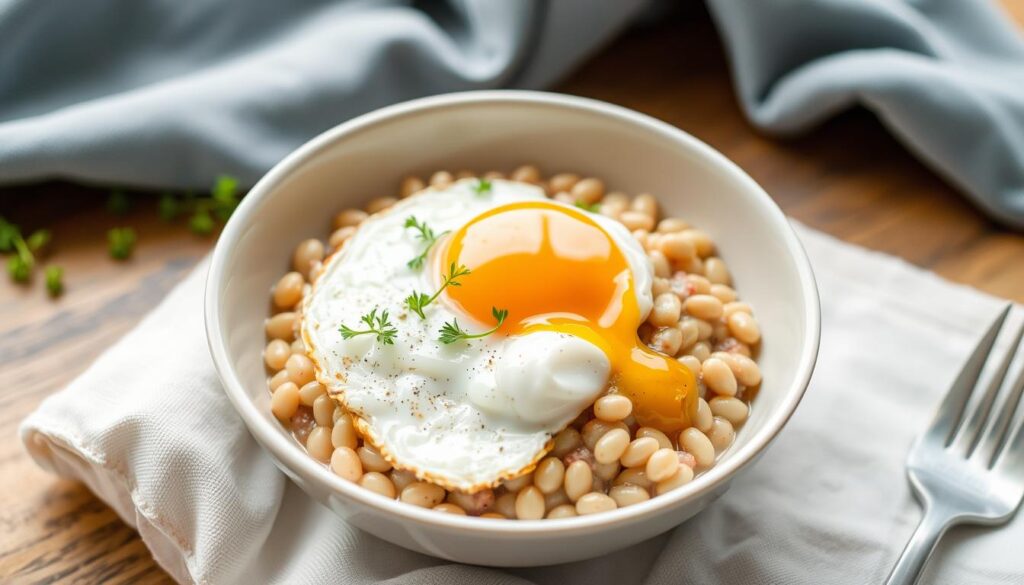
Italian Cheese Gnocchi
In medieval Italy, cheese was a fundamental ingredient in many dishes, including a precursor to modern gnocchi. Unlike today’s potato-based gnocchi, medieval Italian cheese gnocchi were made primarily with fresh cheese, eggs, and flour, showcasing the importance of dairy in medieval Italian cuisine.
These early gnocchi were typically made by combining fresh cheese (similar to modern ricotta) with eggs and flour, forming a soft dough that could be shaped into small dumplings. The gnocchi were then boiled and served with melted butter and grated hard cheese, sometimes accompanied by sweet spices.
The ratio of cheese to flour varied, with wealthier households using more cheese, resulting in a richer final product. Achieving the right consistency was crucial, as too much flour made the gnocchi tough, while too little caused them to dissolve during cooking.
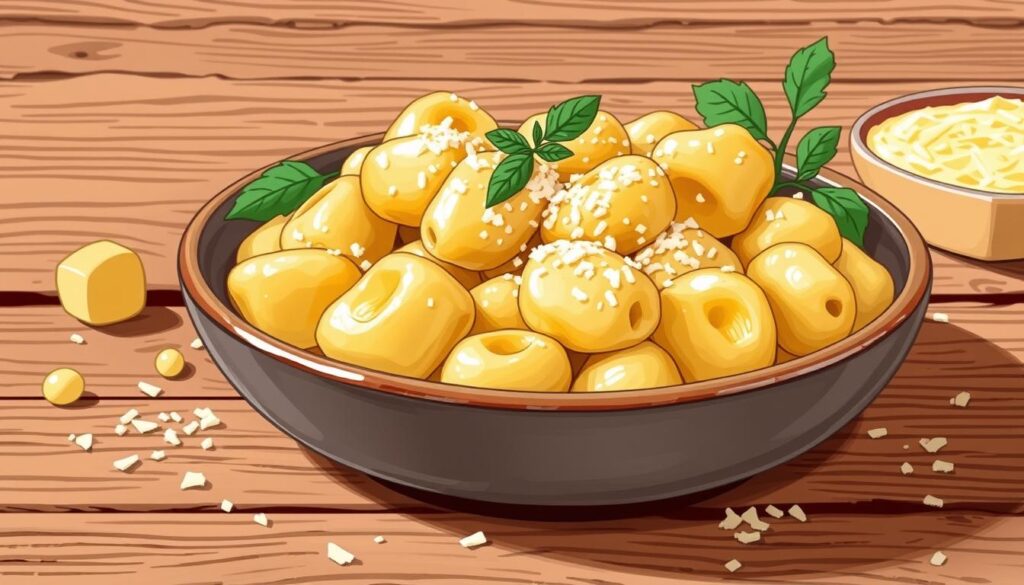
Ancient Roman Culinary Traditions
As we explore Ancient Roman culinary traditions, we uncover a rich tapestry of flavors and cooking techniques that not only reflect the complexity of Roman society but also its cultural exchange and culinary innovation. The Roman cuisine was heavily influenced by its vast territorial reach, incorporating various ingredients and cooking methods from across the empire, thus creating a unique bread culture that was both diverse and sophisticated.
Spiral-Shaped Fried Pastries with Honey

The ancient Romans enjoyed a variety of sweet treats, among which spiral-shaped fried pastries were particularly popular. These pastries, made with flour, eggs, and sugar, were fried to a golden crisp and often drizzled with honey, creating a delightful contrast of textures and flavors. To recreate this dish, one can mix 2 cups of flour with 1/2 cup of sugar and 2 eggs, pipe the mixture into spiral shapes, and fry until golden. Drizzling with honey before serving adds a touch of ancient Roman luxury to this sweet treat.
Fresh Cheese Similar to Farmer’s Cheese

The Romans produced a variety of fresh cheeses, one of which was similar to modern cheese types like farmer’s cheese or young mozzarella. This cheese was made by curdling milk with rennet or fig sap, then draining the whey. The resulting cheese had a mild, slightly nutty flavor and a soft, moist texture, making it versatile for both cooking and direct consumption. To taste this ancient Roman delight, one can curdle milk with vinegar or lemon juice, strain it, and mix with salt and herbs. This simple recipe offers a glimpse into the daily culinary practices of ancient Rome.
18th Century British Recipes
18th century British recipes offer a glimpse into the past, showcasing the culinary practices of the time. These recipes not only highlight the flavors and ingredients of the era but also reflect the social and cultural context in which they were prepared.
Pineapple Tarts with Wine
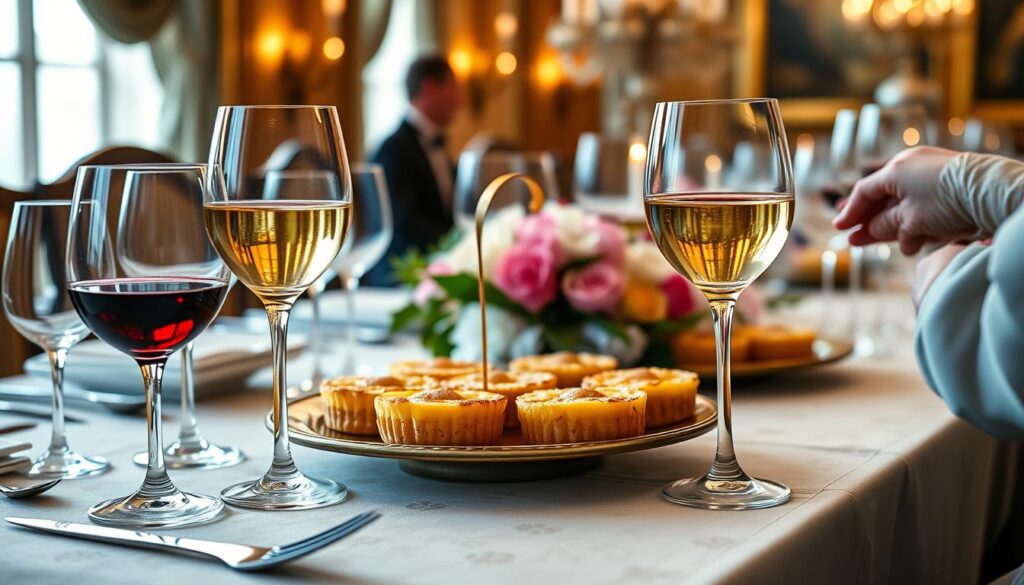
Pineapple tarts with wine were a delicacy in 18th century Britain, symbolizing wealth and status due to the rarity and cost of pineapples. The combination of sweet pineapple, tangy wine, and flaky pastry crust made for a sophisticated dessert.
The preparation involved mixing sugar, eggs, and flour to create a pastry dough, which was then filled with a pineapple and wine-infused filling. The tarts were baked until golden, resulting in a sweet and tangy dessert.
Larded Venison Tenderloin
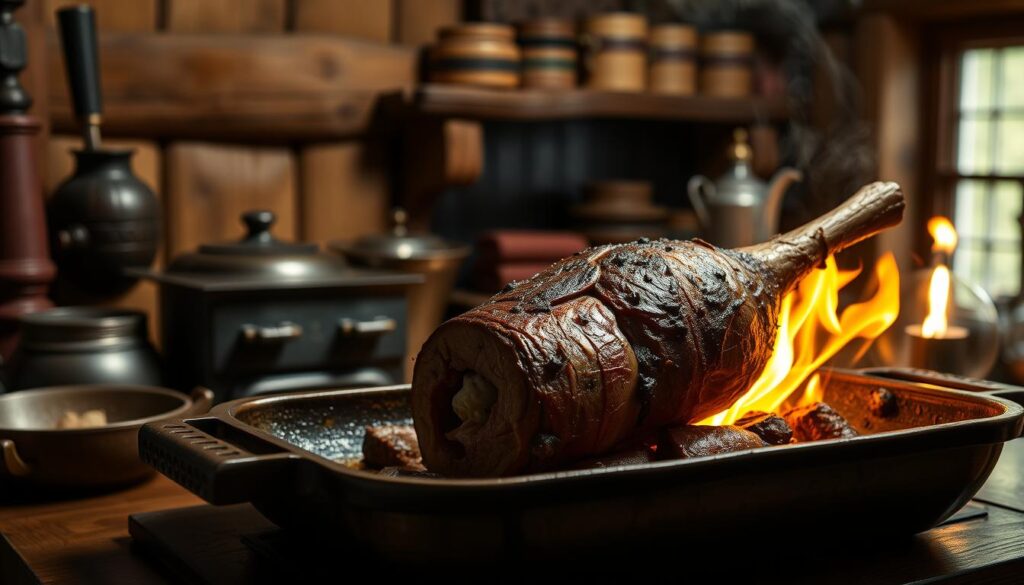
Larded venison tenderloin was a popular dish among the British aristocracy in the 18th century, showcasing their culinary expertise. The technique of larding involved inserting strips of fat into the venison to enhance its flavor and prevent drying out during roasting.
The venison was typically marinated in a mixture of wine, vinegar, and herbs before being roasted. The accompanying wine sauce, made by deglazing the roasting pan with fortified wine and reducing it with meat stock, added a rich flavor to the dish.
The use of sugar in the sauce balanced the acidity of the wine and complemented the natural flavors of the venison, a technique still used in modern fine dining. This dish was often served at the tables of the wealthy, accompanied by bread and seasonal vegetables.
Historical Food Recipes from North Africa and the Middle East
Delving into the historical food recipes of North Africa and the Middle East offers a glimpse into the cultural and culinary practices of ancient civilizations. These regions have been at the crossroads of trade and cultural exchange for millennia, resulting in a rich culinary heritage.
10th Century Baghdad Lamb and Herb Stew
The 10th century Baghdad lamb and herb stew is a testament to the sophisticated culinary techniques of medieval Islamic cuisine. This hearty dish was likely served at banquets and special occasions, showcasing the rich flavors and aromas of the region.
To recreate this historical recipe, we would need ingredients such as lamb, herbs (like parsley and dill), and spices (including cumin and coriander). The stew would be cooked in a clay pot over an open flame, allowing the flavors to meld together.
Ancient Mesopotamian Date and Pistachio Pastries
Ancient Mesopotamian date and pistachio pastries represent one of the world’s earliest documented sweet treats. Archaeological evidence and cuneiform tablets from as early as 1700 BCE describe similar confections, highlighting the importance of dates and nuts in Mesopotamian cuisine.
These pastries featured a filling of mashed sugar-rich dates combined with chopped pistachios, encased in a dough made from flour and water, possibly enriched with olive oil or animal fat. The pastries were baked in clay ovens, resulting in a crispy crust.
Modern adaptations might substitute apples or other dried fruits for some of the dates to create a less intensely sweet version. The combination of dates and pistachios in pastry has shown remarkable longevity, influencing modern Middle Eastern sweets like ma’amoul and baklava.
By exploring these historical food recipes, we gain insight into the culinary practices and cultural traditions of North Africa and the Middle East. These recipes not only provide a connection to the past but also inspire modern cooking with their rich flavors and techniques.
19th Century European Cuisine
The 19th century saw a significant evolution in European cuisine, marked by the emergence of distinct national dishes. This period was characterized by the refinement of traditional cooking techniques and the incorporation of new ingredients and flavors. We will explore two iconic dishes from this era: Russian Beef Stroganoff and Hungarian Goulash Soup.
Russian Beef Stroganoff with Allspice
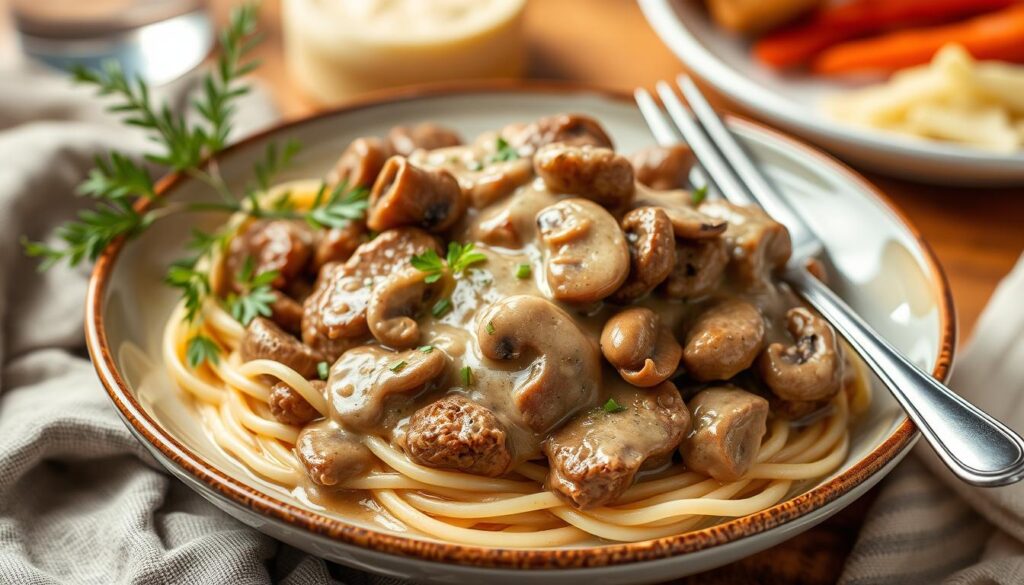
Russian Beef Stroganoff, a dish that originated in 19th-century Russia, is known for its sautéed beef, mushrooms, and creamy sauce. The recipe typically includes beef strips cooked with mushrooms and onions, served in a sour cream sauce flavored with allspice. This dish reflects the Russian cuisine’s emphasis on hearty, flavorful meat dishes. To make it, one would typically use flour to thicken the sauce and serve it over bread or eggs-based noodles.
The use of allspice in Beef Stroganoff adds a unique warmth to the dish, complementing the sugar and spices used in the recipe. This blend of flavors is characteristic of 19th-century Russian cooking, which often combined traditional ingredients with new spices and cooking techniques.
Hungarian Goulash Soup
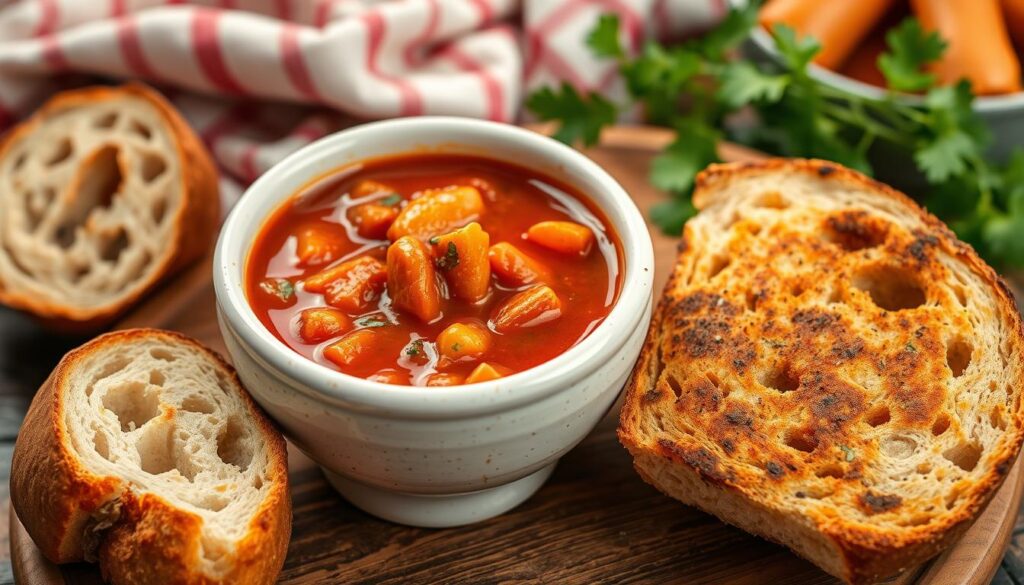
Hungarian Goulash Soup, a staple of 19th-century Hungarian cuisine, was primarily a clear, flavorful broth rather than the thick stew familiar to many today. The authentic recipe featured beef or veal cut into small cubes, slowly simmered with onions that had been sautéed in lard until caramelized. Paprika, introduced to Hungary in the 16th century, became integral to the dish by the 19th century, providing both color and a complex sweet-spicy flavor.
The addition of caraway seeds, garlic, and sometimes wine contributed to the rich flavor profile of the soup. Potatoes, a relatively new ingredient in European cooking at the time, added substance and helped thicken the broth slightly. The soup was typically served with fresh bread, allowing diners to enjoy the clear, flavorful broth as a distinct element of the meal.
American Historical Recipes
As we journey through the annals of American culinary history, we discover delightful recipes from the past that continue to captivate food enthusiasts today. The rich culinary heritage of America is reflected in its diverse historical recipes, which often feature locally sourced ingredients and traditional cooking methods.
Two such recipes that stand out from the 19th century are glacé cherries and traditional eggnog. These treats not only showcase the evolution of American cuisine but also highlight the influence of European traditions on American cooking.
19th Century Glacé Cherries
Glacé cherries, a staple in many traditional American desserts, have a fascinating history. These cherries were made by candying fresh cherries in a sugar syrup, resulting in a sweet and tangy treat. To make 19th-century-style glacé cherries, you’ll need fresh cherries, granulated sugar, and a bit of patience.
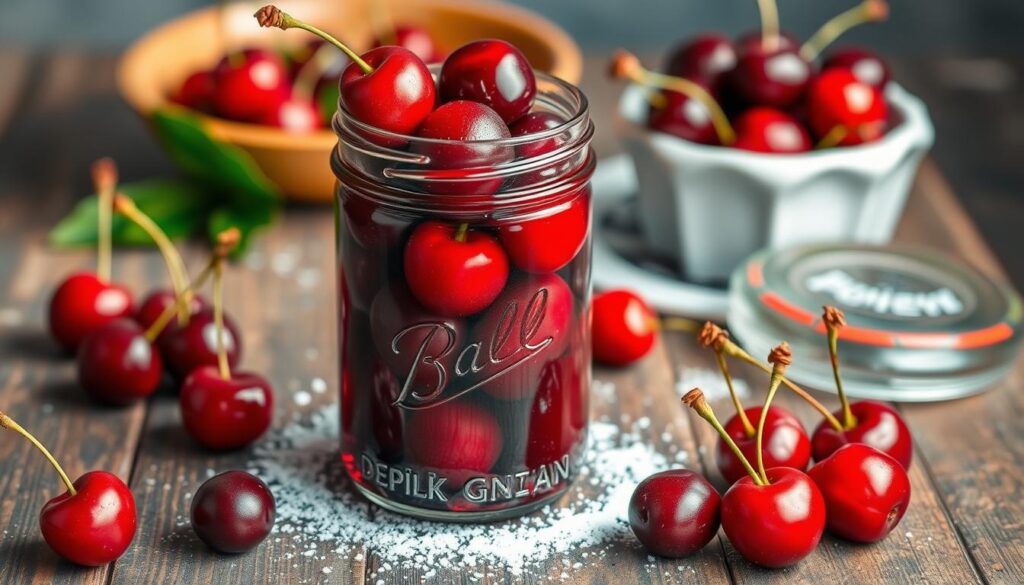
Traditional Eggnog from the 1800s
Traditional eggnog from the 1800s is a rich, boozy, and nutmeggy holiday beverage that bears little resemblance to the commercial versions available today. The basic recipe combines egg yolks beaten with sugar, whole milk or cream, and a generous quantity of spirits—typically a combination of rum, brandy, and sometimes bourbon or whiskey—finished with whipped egg whites for a frothy texture.
The preparation of historical eggnog was often a communal or ceremonial activity, with recipes frequently scaled to serve large gatherings. Unlike modern commercial versions, historical eggnog was made fresh and consumed within days, with the high alcohol content serving as both flavoring and preservative.
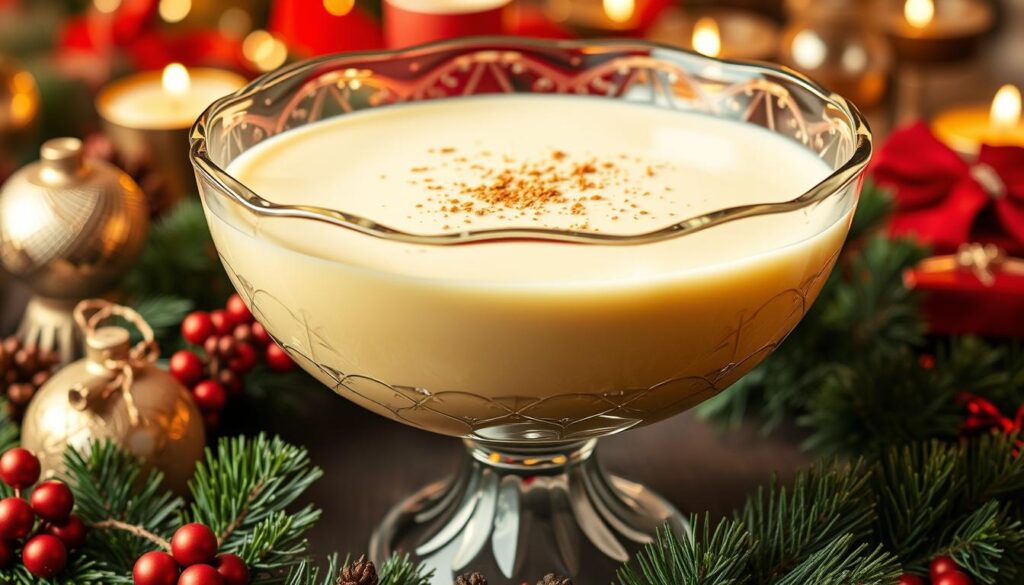
Wartime Recipes from the 20th Century
The scarcity of ingredients during World War II led to the creation of innovative and resourceful recipes that continue to fascinate food historians today. As we explore these wartime recipes, we gain insight into the culinary adaptations that sustained communities during times of hardship.
WWII Dutch Potato and Tulip Bulb Dish
During the harsh winter of 1944-45, known as the “Hunger Winter,” the Dutch population faced extreme food shortages. In desperation, people turned to tulip bulbs as a food source, creating dishes that were both filling and unpalatable. One such recipe involved boiling or frying tulip bulbs, often mixed with potatoes and other available vegetables.
The use of tulip bulbs, though not a preferred ingredient, highlights the resourcefulness of cooks during wartime. While not commonly practiced today, understanding these historical recipes provides a glimpse into the challenges faced by communities under occupation.
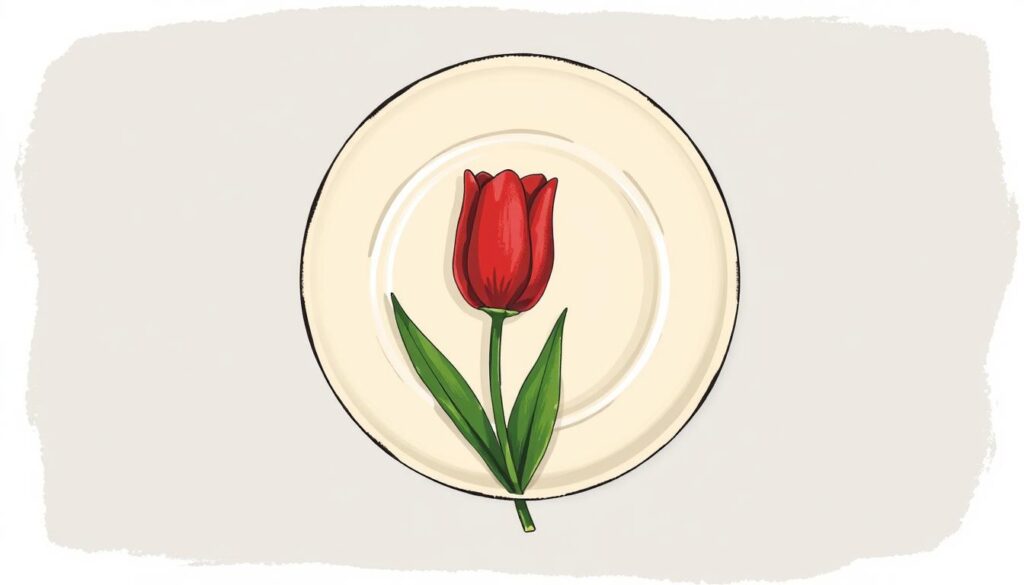
Italian Chestnut Flour Cake
In Italy, during World War II, chestnut flour became a staple ingredient due to the scarcity of wheat flour. Italian chestnut flour cake, a dense and dry dessert, was made possible by the natural sweetness of chestnut flour and the use of lemon zest for flavor. This cake, relying on yeast for leavening, reflects both traditional Italian baking methods and the adaptations necessitated by wartime rationing.
The cake’s dense texture and lack of sugar were characteristic of wartime desserts, designed to be filling rather than indulgent. Regional variations of this cake existed, with some incorporating foraged ingredients like rosemary or pine nuts to enhance flavor.
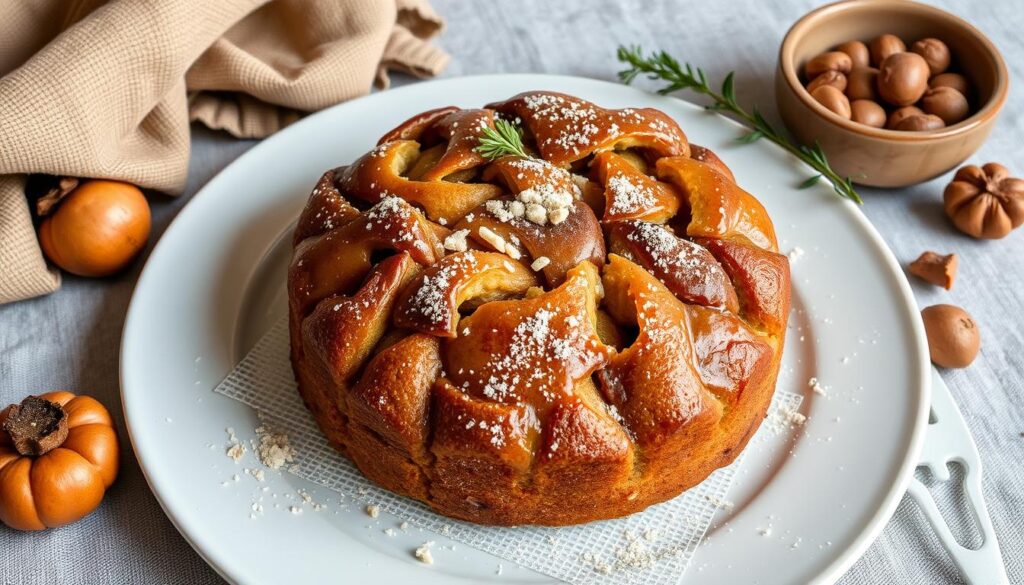
Sweet Treats Through the Ages
The allure of sweet treats has captivated palates throughout history, with each era offering its unique twist on indulgent delights. As we explore the world of historical desserts, we uncover the evolution of ingredients, cooking techniques, and cultural influences that have shaped the sweet treats we enjoy today.
Elizabethan Chocolate Jumballs

Elizabethan Chocolate Jumballs were a beloved treat during the Elizabethan era, known for their intricate shapes and sugar coating. These sweet confections were made with sugar, eggs, and flour, and were often flavored with spices or other ingredients to create a unique taste experience. The use of chocolate in these jumballs was a testament to the growing influence of New World ingredients in European cuisine.
The process of making these jumballs involved carefully shaping the dough into various forms, which were then baked and coated in a layer of sugar. The result was a delicate, sweet treat that was both visually appealing and delicious. The inclusion of chocolate added a rich, velvety texture that elevated these jumballs to a luxurious indulgence.
18th Century French Tosts
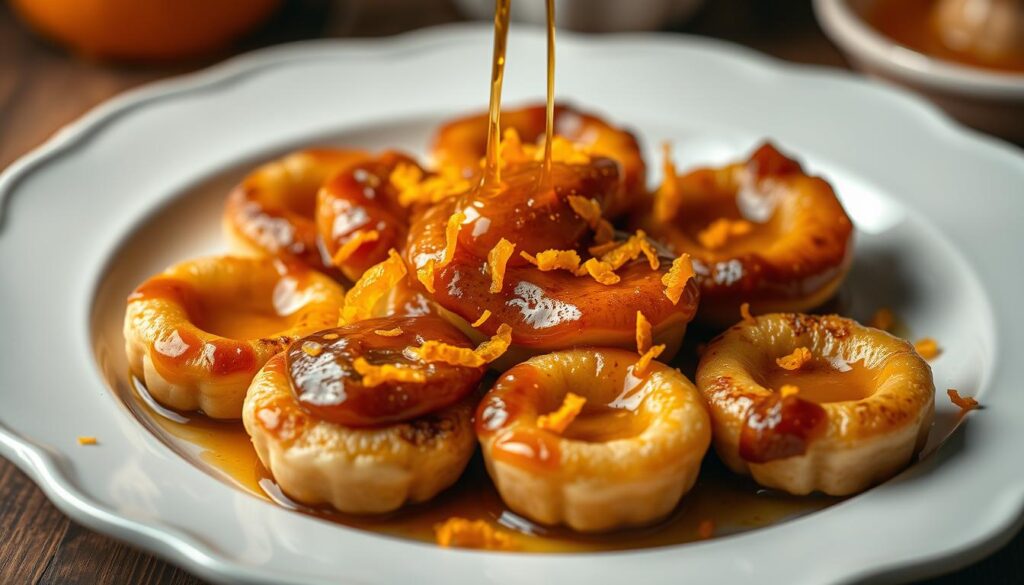
18th Century French Tosts represent an early version of what we now know as French toast, though the historical preparation method and flavor profile differ significantly from modern interpretations. This elegant breakfast or light dessert dish began with slices of white bread toasted until lightly browned, then soaked in a mixture of cream, sugar, and orange juice—a combination that created a distinctive caramel flavor as it cooked.
Unlike modern French toast, which is typically dipped in an egg mixture and fried, this historical version was gently steamed between two dishes set over hot coals, creating a tender, pudding-like interior while maintaining some crispness from the initial toasting. The absence of eggs in some versions of this recipe distinguishes it from the egg-soaked pain perdu tradition, though related recipes in the same period sometimes included eggs for a richer variation.
Historical Pastries and Breads
Delving into the world of historical pastries and breads, we uncover the stories behind these traditional baked goods. From medieval fried pastries filled with fruit and nuts to crispy American sugar cookies from the 20th century, each recipe tells a tale of cultural heritage and culinary innovation.
These baked delights not only satisfied hunger but also played significant roles in religious, social, and cultural practices throughout history. As we explore these historical treats, we gain insight into the lives of our ancestors and the evolution of baking techniques.
Medieval Fried Pastries with Fruit and Nut Filling
Medieval fried pastries with fruit and nut fillings were a delicacy in medieval Europe, often served at special occasions. These pastries were made with a simple dough of flour, water, and sometimes eggs, which was then fried in hot oil.
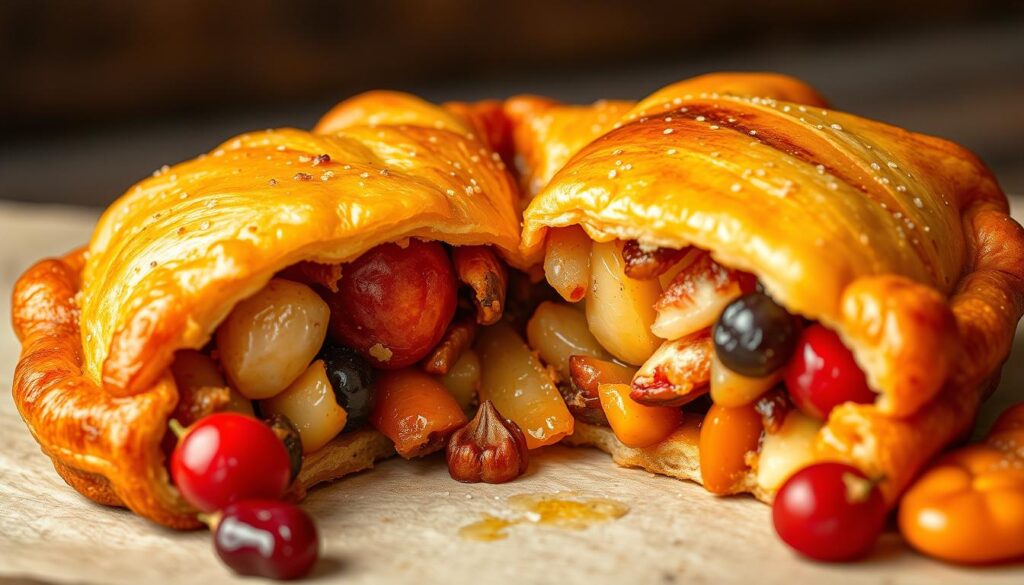
The filling typically consisted of a mixture of fruits, nuts, and spices, showcasing the medieval love for combining sweet and savory flavors. To make these pastries, cooks would carefully prepare the dough, fill it with the fruit and nut mixture, and then fry them until golden brown.
Crispy American Sugar Cookies from the 20th Century
Crispy American sugar cookies became a staple in the early to mid-20th century, featuring in community cookbooks and commercial baking mixes. These cookies were made with a simple dough of flour, sugar, butter, eggs, and vanilla.
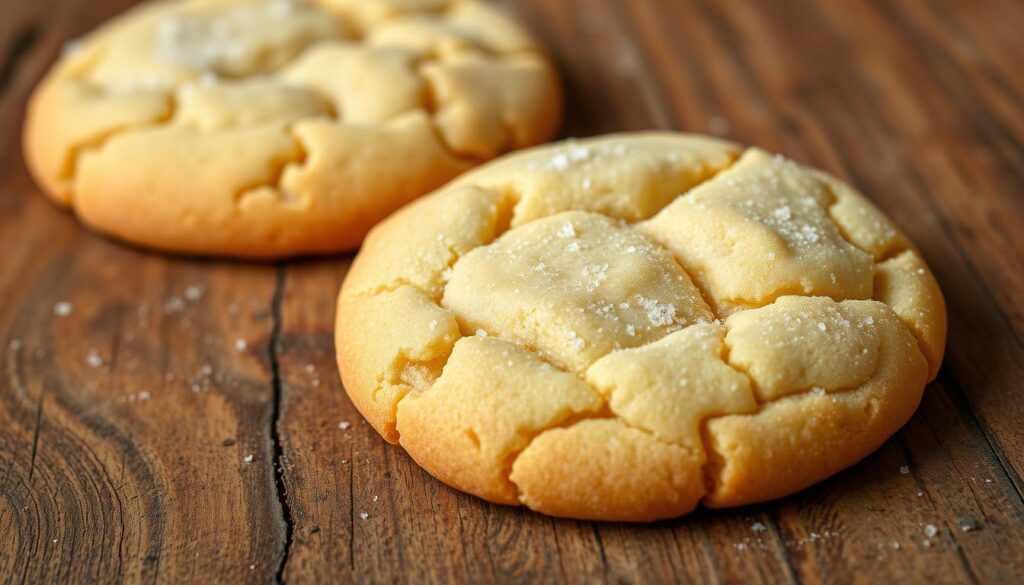
Their distinctive crisp texture came from the precise ratio of ingredients and specific baking techniques. Unlike modern chewy cookies, traditional 20th-century sugar cookies were intentionally crisp throughout, with a satisfying snap when broken.
The simplicity of these cookies made them an ideal treat for various occasions, from after-school snacks to holiday traditions. Achieving the perfect crispy sugar cookie required attention to details like proper creaming of butter and sugar, careful measurement of flour, and precise baking time and temperature.
Asian Historical Recipes
Exploring the rich culinary heritage of Asia, we uncover historical recipes that continue to inspire modern cooking.
Filipino Rice and Egg Noodles with Shrimp
The Philippines offers a diverse culinary landscape, with dishes influenced by various cultures, including Chinese, Spanish, and Malay. One traditional Filipino noodle dish, pancit, combines rice and egg noodles with shrimp, pork, and vegetables, showcasing the country’s love for stir-fried noodles.
This complex recipe involves cooking the noodles, preparing a mixture of eggs, vegetables, and shrimp, and then combining everything in a wok over high heat, a technique reminiscent of ancient Chinese “fan-chien” stir-frying methods.
The result is a flavorful dish that highlights the balance of textures and tastes, with the sweetness of the shrimp and the savory flavor of pork or meat additions.
Ancient Chinese Cooking Techniques
Ancient Chinese cooking techniques, as documented in texts like the “Qimin Yaoshu” from the 6th century CE, reveal sophisticated approaches to food preparation that have influenced culinary traditions throughout East Asia.
Techniques such as “fan-chien,” or rapid stir-frying in a wok, allowed for quick cooking while preserving the texture, color, and nutritional value of vegetables and meat. Precise cutting techniques were also fundamental, requiring specific knife skills for different ingredients.
The emphasis on the balance between “fan” (grains) and “ts’ai” (vegetables and meat) reflected Chinese philosophical concepts of harmony, with recipes designed to create complementary dishes. Steaming, as a cooking method, preserved natural flavors with minimal added fats, and preservation techniques like salting, drying, and fermenting extended the availability of seasonal ingredients.
These ancient techniques demonstrate a remarkable continuity in Chinese cooking, with methods from over 1,500 years ago remaining fundamental to Chinese cuisine today, influencing not just local but also regional cooking styles across Asia.
The Art of Historical Recipe Adaptation
The art of adapting historical recipes involves more than just following old instructions; it demands creativity and culinary expertise. As we explore historical cookbooks and manuscripts, we find that ancient recipes often lack precise measurements and cooking times, requiring us to interpret and adjust them for modern kitchens.
When adapting historical recipes, one of the primary challenges is substituting rare or extinct ingredients. Historical recipes often called for ingredients that are no longer available or have been replaced by modern alternatives. For instance, ancient Roman recipes might include defrutum, a syrup made from boiled-down fruit, which can be substituted with a mixture of honey and apple cider in modern cooking.
Substituting Rare or Extinct Ingredients
To successfully adapt historical recipes, we need to understand the role of each ingredient and find suitable substitutes. This might involve using modern equivalents or creative alternatives. For example, if a historical recipe calls for a specific type of sugar that is no longer available, we can experiment with different types of sugar or syrups to achieve a similar flavor profile.
| Historical Ingredient | Modern Substitute | Notes |
|---|---|---|
| Defrutum | Honey and Apple Cider Mix | Mix honey with apple cider to achieve a similar consistency and flavor |
| Verjuice | Grape Juice or Unripe Grape Syrup | Use as a substitute in recipes calling for acidic ingredients |
Adapting historical recipes also requires adjusting cooking times and temperatures. Historical cooking methods, such as open hearth cooking or baking in communal ovens, involved different heat control techniques than those used in modern kitchens.
Adjusting Cooking Times and Temperatures
Historical recipes rarely specified precise cooking times or temperatures, instead using descriptive instructions like “a quick oven” or “until done.” To adapt these recipes, we need to understand the cooking techniques involved and standardize the instructions for modern cooking methods.
For example, bread baking in historical times often relied on residual heat in communal or brick ovens. To replicate this in a modern kitchen, we can start baking at a higher temperature and then reduce it to simulate the gradual decline in heat.
By understanding the principles behind historical cooking techniques and making informed substitutions and adjustments, we can successfully adapt historical recipes for modern kitchens. This not only preserves culinary heritage but also allows us to experience the flavors and traditions of the past.
How Historical Recipes Influence Modern Cuisine
Historical recipes continue to shape modern cuisine in ways both subtle and profound. As we explore the rich culinary heritage of the past, we find that many contemporary cooking practices have their roots in traditional methods and ingredients.
The revival of traditional cooking methods has been a significant factor in the evolution of modern cuisine. Chefs are now rediscovering and adapting historical techniques, such as whole animal butchery and artisanal grain production, to create innovative dishes that pay homage to the past while embracing modern flavors and presentation.
Revival of Traditional Cooking Methods
The modern emphasis on using locally sourced ingredients and reducing food waste echoes historical practices where nothing was wasted. For example, chefs are now rediscovering traditional recipes for organ meats and other parts that were previously overlooked. This approach not only reduces waste but also offers a more nuanced understanding of the animal’s culinary value.
The use of heritage grains in baking is another area where historical practices are influencing modern cuisine. Artisanal producers are reviving ancient varieties of wheat, rye, and corn, which offer complex flavors and nutritional profiles that are distinct from their modern counterparts. This revival is influencing everything from bread baking to craft whiskey production.
Farm-to-Table and Slow Food Movements
The farm-to-table movement draws direct inspiration from historical necessity, when ingredients were sourced locally and menus were dictated by seasonal availability. This approach has led to a renewed interest in preservation techniques like canning, smoking, and fermenting, which were essential for extending the availability of summer and fall harvests.
The Slow Food movement’s emphasis on traditional food ways directly connects to historical recipes and techniques, preserving cultural knowledge that might otherwise be lost. By celebrating the rich culinary heritage of the past, we can create a more sustainable and flavorful food culture for the future.
As we continue to explore the influence of historical recipes on modern cuisine, we find that the connection between past and present is not just about nostalgia, but about creating a more resilient and vibrant food system. By embracing traditional techniques and ingredients, we can add depth and complexity to our cooking, while also honoring the culinary traditions that have shaped our modern palate.
Preserving Culinary Heritage Through Historical Cooking
Preserving culinary heritage through historical cooking is more than just a hobby; it’s a way to connect with our past. By recreating traditional dishes, we can experience the tastes, aromas, and textures that shaped our ancestors’ daily lives and special celebrations.
Community cooking projects focused on historical recipes play a vital role in building intergenerational connections. Elders share techniques and food memories, preserving cultural knowledge that might otherwise be lost. For instance, traditional bread baking and cheese making skills are passed down, along with stories of family traditions and cultural heritage.
Historical cooking also provides practical knowledge that builds self-sufficiency and resilience. Skills like preserving fruits, smoking fish, and making pastry dough are valuable in today’s world. Moreover, the revival of historical recipes often reveals sustainable practices, such as utilizing every part of an animal or plant and cooking with minimal fuel consumption.
The study of historical cooking techniques offers insights into how communities adapted to environmental challenges and technological changes. Recreating historical meals with their distinctive progression of courses—from savory soups to dessert—helps us understand how dining patterns and food values have evolved. The balance of sweet savory flavors in historical cooking often differed from modern preferences, challenging our contemporary taste expectations.
As we continue to explore historical cooking, we not only preserve our culinary heritage but also gain a deeper appreciation for the techniques and traditions that shaped our culinary identity. By embracing historical cooking, we can create a more sustainable and culturally rich food culture.
